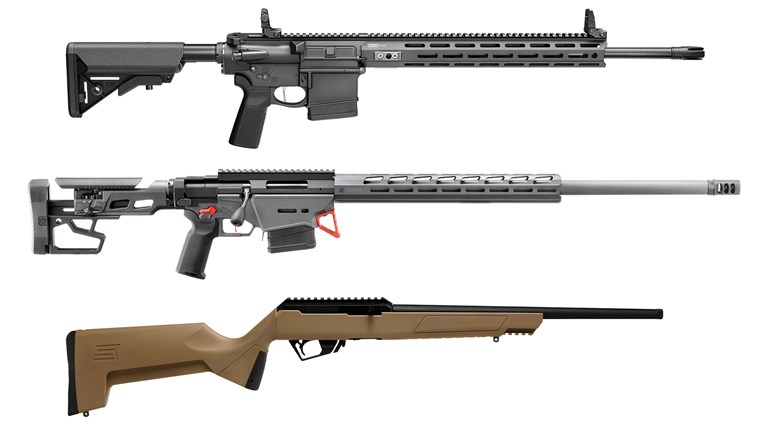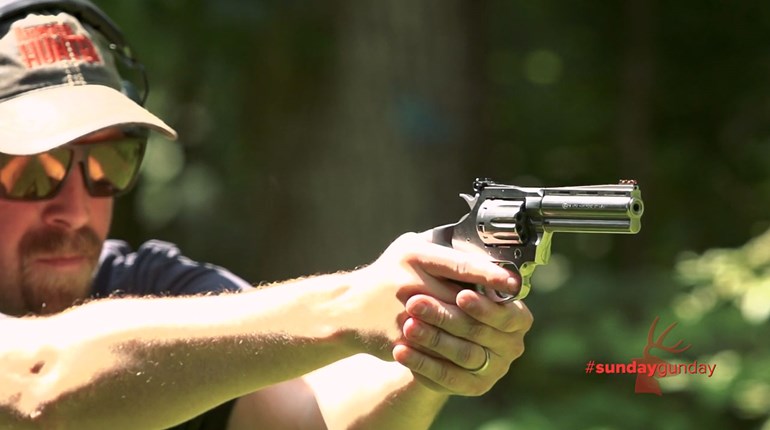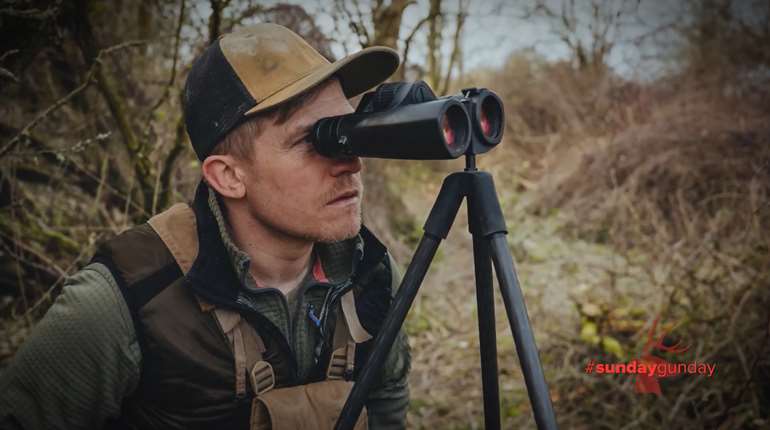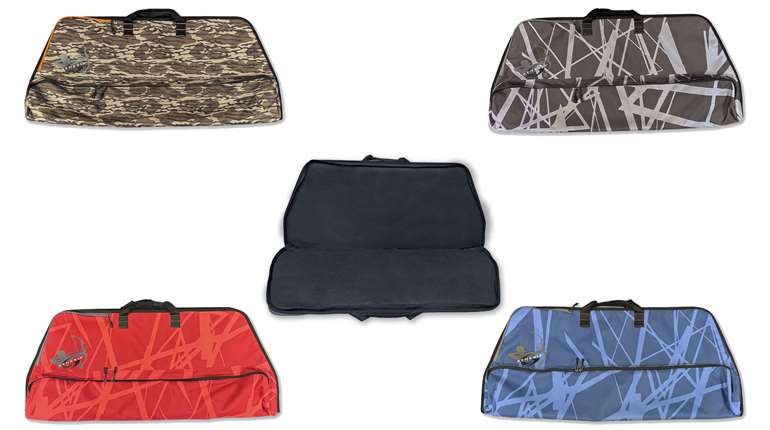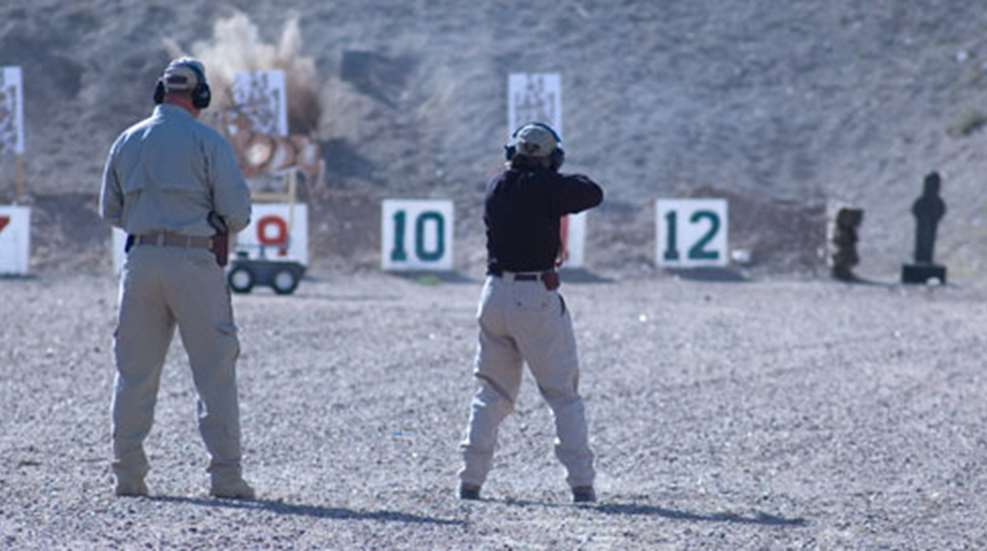
The land Gunsite Academy now sits on was 160 acres of desert when Jeff Cooper and his wife, Janelle, first saw it in 1974. Cooper was a retired Marine and an NRA Board member. But he was perhaps best known as the guru of the .45 ACP, no doubt because of his many writings on the subject for Guns & Ammo magazine for many years. He thought the land would do nicely as a pistol school, and he founded the American Pistol Institute there, in Paulden, Ariz., in 1976.
In 1992, a new owner renamed it Gunsite Training School. It 1999, it became Gunsite Academy, and today the complex encompasses 2,200 acres of pistol, rifle and shotgun ranges. Every year, civilians, and law enforcement and military personnel flock there for specialized training.
In 2009, I enrolled in the Academy’s Hunter Prep course, a five-day amalgam of riflecraft aimed at big-game hunters who want to assess their skills and perhaps tune-up before traveling abroad.
As a former Marine, lifelong shooter and hunter, and an NRA-certified rifle instructor, I didn’t need to verify what I already knew, but I wanted to learn what I didn’t know. Specifically, I wanted to ferret out the reason for a couple of disturbing missed shots on game in recent years. Was it physical? Was I doing something fundamentally wrong during the setup and shot? Or was it mental?
The Right Mindset
Gunsite doesn’t get a lot of beginners in any of its courses, but that’s not to say the level of experience doesn’t vary among students. In my course there was a retired chemist, a retired cardiologist, a former college basketball coach, a PR/marketing representative from the firearm industry and others. With that kind of lineup it’s safe to say our level of hunting experience varied greatly; all of us had hunted throughout our lifetimes, but some of us had done so extensively throughout the world.
Hunter Prep begins in the classroom (but it doesn’t stay there long). Our rangemaster and chief instructor, Il Ling New, introduced herself and our coaches, Mike Moore and Ron Fielder, then went over the range rules and the basics of firearm safety. Then she launched into the philosophic mindset espoused at Gunsite.
First she defined a practical rifle: it is compact, lightweight, powerful and accurate. Accuracy here is defined as something you can use effectively, which needn’t be as accurate as one might think. Most factory rifles are, after all, more accurate than the average rifleman. So the attention quickly shifts to the definition of a practical rifle shooter. He is able to hold still through the shot process, through the dwell time (when the bullet flies to its target), through recoil, and recover to engage the target again, if necessary. A practical rifleman’s most important goal, then, lies in his control over his mind and body.
Which leads to the combat triad first defined by Jeff Cooper, Gunsite’s founder (everything at the academy bears his stamp). The triad is the union of gun handling, marksmanship and mindset in the rifleman. A hunter must harness all three appropriately so succeed. Now, the word “combat” probably raises a few hackles with hunters. After all, we shouldn’t make war on the game we hunt. But combat can be defined as any conflict between groups or individuals. Therefore, a hunter who enters the field with the intention of shooting—indeed, killing—the game he seeks is in fact engaging in combat with that individual animal. In that light, it’s important to enter the field with the right mindset.
The classroom portion didn’t end there; we regularly met inside throughout our five-day course to discuss other academic subjects. But that first morning I was enthused when I learned about the triad of gun handling, marksmanship and mindset. I knew my mastery of the first two was well exceptional, notwithstanding some tweaks I expected Gunsite instructors to make with my technique. So I was most interested in the third property of the triad: mindset. Was the lack of a proper spirit the reason for my recent misses? Had I hunted so much that I’d become complacent about killing game? Was I taking things for granted?
The answer to such a question is personal; no one can make the determination for us. Me? I don’t think I’ll ever enter the field again without thinking about what a blessing I’ve been given. When I’m hunting I’m not sitting behind a desk or sitting in traffic, nor am I worried about day-to-day activities of my life. I’m blessed with the freedom to choose my activity for that day, that moment in time. So I go afield and have fun—that’s the point of a pastime. But now I take it more seriously than ever. I figure I owe it to the game I hunt.
Live-Fire
On the range, New described each of the basic field-shooting positions in detail. There are nuances to each of them, too many to list here. Instead, I’ll list the finer points I learned, and perhaps the experienced riflemen among you also will learn a thing or two.
Prone is the steadiest, to be sure, but not always practical. Terrain and vegetation usually conspire to limit our choice of the lowest possible position we can take. So before we decide to plop down we’d better know whether it will work; the game won’t stand around while we decide to rise to a sitting or kneeling position. But when lying down, be sure to spread your legs far apart to create a “Y” with your body. Point your toes outward and keep you heels flat on the ground to limit their movement, either from muscle twitches or wind.
Dropping to the seated position shouldn’t be a drawn-out affair. Too many hunters plop to their butt first, then bend their legs inward, then raise their rifles to their shoulders. By then, too often the game has moved. Instead, cross your legs, then drop straight to your butt, using your right hand (if you’re a right-handed shooter) to brace your fall. Seat your support (left) elbow first, then position the rifle butt in your shoulder. Now sink into position as you acquire your sight picture. Crouched low, many hunters might be uncomfortable; their diaphragms will be compressed and it will be hard to breathe. Also, bending one’s knees into such a position will stretch ligaments that haven’t been exercised like this in years. Practice helps you find the sweet spot, and stretches ligaments, too.
The kneeling is my favorite, but in high wind it can be touch-and-go. This shooting “platform” will provide only one point of contact with your body—your support elbow on your knee. And your strong-side elbow dangles unsupported. But you’re able to adopt the position and rise from it quickly, which provides the ability to move quickly should the game shift position.
The best thing I learned at Gunsite about the kneeling is the use of the Safari Ching Sling. I’d heard of it, but until instructors talked me into using it I never thought it would be such an effective tool. It’s sold by Galco Gunleather and it improves accuracy without robbing speed from your setup. One piece of leather is split vertically in the middle of the run, and a loop runs between that split. It’s secured with Galco’s Keyhole Lock system, which makes fitting the loop to different shooters fast and tool-free. The key to the sling’s use is securing it before you adopt your position; done backwards, you’ll look like Sad Sack fumbling with arms, elbows and leather. Before dropping to your knee, pull the loop high up your support arm, close to your armpit. After dropping, place your support elbow on your knee, and feel the steadiness the sling provides. Jeff Cooper said it improved accuracy by as much as 30 percent. I don’t know how to measure that, but I do know I’ll never hunt without mine again.
The offhand, or standing, position is the least stable, and as such it should be used only as a last resort when the target is close and time is of the essence. Il Ling New taught us to square-up to the target rather than stand blade-like, with your right leg back. When you don’t have to drop one leg to the rear you can snap in more quickly, but moreover you’re prepared to soak up recoil, which is key here to accuracy. In the blade position, heavy recoil is likely to send your shots to the right. Squared-up, recoil is sent straight back and shots are more likely to stay on target.
We practiced the offhand position from 5 to 75 yards. With practice, I was surprised how quickly I could snap in and effectively engage targets at any range. Now, at first blush, one might ask why we would need to fire at 5 yards. Besides, isn’t hitting a target at such close range a no-brainer? Not necessarily. For starters, you need to know where your rifle prints at any range. At 5 yards, the difference between your line of sight through the scope and the bullet’s path as it exits the muzzle is magnified; the result is point of impact quite low to what is expected. It’s worthwhile to know what that difference is if you plan to hunt dangerous game, or deliver a coup de grace on wounded game. At 75 yards point of impact should be spot-on. But practice at longer range soon reveals the need to leave your scope on a low power to provide greater field of view and less reticle bounce on the target.
Focus and Squeeze
We engaged targets from the prone, sitting and kneeling positions from 50 to 400 yards on three ranges, in slow-fire and rapid-fire exercises. Gunsite doesn’t use a traditional bullseye target with an 8- or 10-inch solid circle in the middle. Rather, theirs is a mottled khaki-and-brown camouflage target. Multiple aiming points can be focused on in the intersections between all those khaki-and-brown spots. The rifleman’s job is to pick one and focus on it, much like he would focus on a spot within a uniform patch of hair in the vital zone of game.
All the while instructors advised us breathe, obtain our sight picture, focus on the reticle, squeeze the trigger and follow-through. Above all, they said, during the shot process you must ignore the target once your sight picture is acquired. This is basic advice, but difficult for anxious shooters to apply. Everyone wants to see where their shots land. But if you’re concentrating properly, and calling your shots when the rifle fires—that is, recognizing where the reticle is when the rifle fires—you should know where your shots are landing.
Still, I had to re-learn the lesson. Mike Moore caught me using the riflescope to check my groups. “Ideally,” he said, “you won’t see the animal’s reaction through the scope, because you’ll be focused on the reticle; the animal will be blurry.” He’s right. In the field I’ve been able to see the animal’s reaction to my shot through the scope. Still do, sometimes. But that isn’t always a good thing. It could mean I’m focused on the animal instead of the reticle as I squeeze the trigger. Which might explain some of my misses in recent years.
I’d traveled to Gunsite, most importantly, to solve a case of the “yips” I’d developed. Misses in recent years had been unexplainable; the shots all felt good, I’d had good sight pictures, good trigger squeezes and good follow-throughs. But still I’d missed sometimes, which left me scratching my head. Whether Moore’s advice will solve the problem I don’t know, but besides my own mantra of “breathe, squeeze, follow-through,” I now remind myself of his words before every shot.
You Can’t Do This at Home
We didn’t limit ourselves to live fire at known ranges—we had a lot of fun at unknown ranges, too. On two other courses of fire we walked trails with coaches, and when “game” was spotted we picked our position and fired. The “game” in this case was either 3-D targets of various animals encountered around the world—elk, whitetails, bears, kudu, impala, lions—or steel plates 50 yards or several hundred yards away. There was no coaching; we were on our own. If a steel plate was hit it was obvious. So sometimes a “clang” elicited “good shot,” but sometimes nothing was said by the instructor. Either way, it was about as realistic as one could hope to find without actually hunting. In the field, after all, we’re often on our own.
It’s up to us as hunters to know what will happen when we squeeze the trigger.
Another range was called the Scrambler. Here, shooters engaged seven steel targets at 50 to 100 yards. Each target was to be hit twice before moving to the next firing point, which was 5 or 15 yards away. Our final scores were based on the number of hits on each target and time. Shooters could forego a second hit on a target if they encountered difficulty, choosing speed over accuracy, but misses counted more than extra time. It took several seconds to complete the course, or several minutes, depending on each shooter’s abilities and physical fitness. Regardless, there was plenty of huffing and puffing at the end.
After running the course the first time, it was clear to me one target stood in the way of a good score. At this position, shooters slithered into a rectangular box about the size of a man, poked the rifle out the front, found the target, engaged it, chambered another round (with limited elbow room) and fired again, then slithered out and moved to the next firing point. Or they cheated, skipping the slithering and using the box as a rest, thus forfeiting any meaningful points at that firing point. Which didn’t really matter, because in Hunter Prep students aren’t earnestly scored on the Scrambler; the point is to build confidence in one’s abilities rather than engage in a race. Still, the Scrambler became our favorite course of fire. I shot it twice before I got cocky.
Ron Fielder had advised us that the record for the Scrambler—33 seconds—was held by a Marine. “Well,” I said, “I doubt I’ll beat that, but here goes.”
Fielder said “go,” and I fired. Three-plus minutes later, breathing heavily, I was disappointed at my time. I shook my head in disbelief.
“That’s not bad, Scott,” said Fielder. “Remember, that Marine was using an M16 and one magazine. He didn’t have to reload. He was a young guy, in excellent shape. He ran from target to target, squatted, fired and moved.”
I reconsidered my situation. I was using a bolt-action Kimber .308, which held only four rounds in the magazine. I started with a full magazine, but hitting seven targets twice each meant at least three reloads. I had to decide whether to top off the magazine after engaging each target, or to reload the magazine fully only after it was empty. And I had to decide whether to do that at a firing point, while stationary, or while on the move. Suddenly, three-plus minutes didn’t seem that bad.
Finally, we engaged a moving target, a robot operated by Mike Moore with a life-size whitetail target on a frame that moved to and fro at about 60 yards, sometimes closer, sometimes farther away.
The key here was recognizing the speed and direction of the target. Clearly, if it was moving straight toward us or directly away one needed only to wait until it turned broadside again before obtaining a sight picture and firing. But when it was moving laterally across our front there was a lead involved. Or was there? It moved slowly, we noted; clearly not as fast as a deer might run, but rather more like it might trot. Moore advised us to swing with the target, to concentrate on the reticle as we squeezed and to keep swinging when the round fired. Some shooters had difficulty at first, but it was more mental than physical.
Lesson learned: Gauge the speed and distance of the game. If the speed is anything less than a run, and the distance anything within 100 yards, one can simply acquire his sight picture, swing with the target as it moves laterally across the zone of fire and squeeze as he continues to swing the muzzle with the target.
I’d never engaged moving targets before. If you must admit the same, consider this exercise alone as worth the trip to Gunsite. But if that’s not enough, consider all the other exercises I’ve described: courses of fire from 5 to 400 yards; life-like “game” trails; the Scrambler. I don’t know about you, but I can’t find qualified, personal shooting instruction for less than a couple hundred bucks a day. And I don’t have access to a 400-yard public range, nor do I have the room on my own land to build one.
About Gunsite
Hunter Prep is an introductory course to help hunters assess their marksmanship skills in a professional environment. Whether you’ve hunted the world or are preparing for that hunt-of-a-lifetime, the aim is to snuff out bad habits, learn good ones and go home thinking about what you can do better the next time you go to the range. Upon graduation from their first course, students become part of the Gunsite “family,” receiving regular updates from Academy personnel about course offerings and other news.
Many courses, like Hunter Prep, have no prerequisites. Others do; you must complete Precision Rifle 7, for instance, before taking Extreme Long Range Rifle. And many students do exactly that, because the place and the people are infectious. Shooters return here year after year because they want to hone their technique before an expensive hunt, or because they simply want to learn new skills.
The tuition for Hunter Prep is $1,428. Room and board are not included, nor is airport pickup. You must fly into Phoenix, rent a car and drive a couple hours to Paulden, Ariz.
Many places of lodging are nearby. But if you go, I suggest you contact Ann Harrington at Little Thumb Butte Bed & Breakfast. Ann is a retired teacher, an NRA member and a Gunsite graduate, and she has special rates for Gunsite students. For $80 a night, you get a clean room only 8 miles from the Academy, a home-cooked dinner and a hot breakfast—an excellent deal. Contact her at 928-636-4413, or check out her website.












